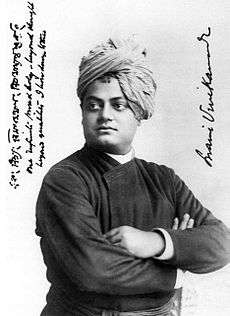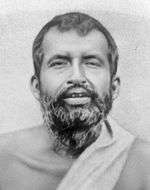Khandana Bhava–Bandhana
| "Khandana Bhava–Bandhana" | |
|---|---|
Song by Swami Vivekananda  | |
| Genre | Prayer |
| Writer(s) | Swami Vivekananda |
| Composer(s) | Swami Vivekananda |
| Language | Bengali |
|
Based on Raga Mishra Kalyana, Tala Ferta (Choutal, Tintal, Ektal) | |
Khandana Bhava–Bandhana,[lower-alpha 1] or Sri Ramakrishna Aratrik,[1] or Sri Ramakrishna Arati,[2] (English: Breaker of this world’s chain),[3] is a Bengali song composed by Hindu monk Swami Vivekananda.[4][5] The song, dedicated to the 19th-century mystic Ramakrishna,[6] was composed in 1898.[7][8] It is a prayer song, based on Raga Mishra Kalyana, Tala Ferta (Choutal, Tintal, Ektal) used in Indian classical music.[1]
Vivekananda's message through the poem was to free one self from the bondages of the world, and to make those who have freed themselves spread their knowledge of freedom widely until the whole humanity is filled with tremendous passion for freedom (from bondage and suffering).[9]
History
Vivekananda was the star disciple of the holy saint Sri Ramakrishna, who died in 1902. To follow Sri Ramakrishna's teachings, Vivekananda established Ramakrishna Math monastic order, which became part of the Hindu reform movements for regeneration to Hinduism. He became a key figure in the introduction of Indian philosophies of Vedanta and Yoga to the western world. He toured the United States and Europe. In 1898, he was in Calcutta, India, taking part in the consecration of Ramakrishana Math monastery set up in the house of Nilambar Babu, a disciple of Ramakrishna. Vivekananda wrote the poem during his stay there.
This arati is sung in all Ramakrishna maths and Ramakrishna missions in their daily prayers.[10][11]
Theme
Vivekananda's deliberate attempt was to free individuals and relieve them from sufferings and bondage. He dedicated his life to this work. The same passion can be found in this prayer song.[9]
 |
Khandana Bhava–Bandhana
Listen to the full hymn by Vivekananda
Dedicated to Sri Ramakrishna (pictured) |
| Problems playing this file? See media help. | |
In this hymn Vivekananda addresses Ramakrishna, his master and praises him. He says his master is the breaker of the world's chain who is spotless who came to this world taking human form, he is embodiment of divine knowledge. He looks at the eyes of his master and finds they are bright with the wisdom of God and feels that can wake him from Maya. He again praises his master for his sacrifice as he thinks his master freely chose to take birth "in this prison" to unchain men from prison. Finally he requests his master's blessings and requests him to come to his heart's black cave and illuminate it, since his master, in his view is "light of the light".[3]
Lyrics
The Hymn to the Divinity of Shri Ramakrishna poem/song by Swami Vivekananda was written in Bengali, Sanskritized and translated numerous times. Its English text is rendered from the Bengali original.[5]
See also
References
- Notes
http://skylinkworld.co.uk/hindu-pilgrimage
- Citations
- 1 2 "Poet Swami Vivekananda" (in Bengali). Milansagar (online magazine). Retrieved 17 December 2012.
- ↑ "Sri Ramakrishna Arati" (PDF). Indian Institute of Technology, Kanpur. Retrieved 17 December 2012.
- 1 2 "Breaker of This World's Chain". Vedanta.org. Retrieved 17 December 2012.
- ↑ "Swami Vivekananda biography". Gujarat Government. Retrieved 17 December 2012.
- 1 2 Suresh C. Dey (1 December 1990). The Quest For Music Divine. New Delhi: APH Publishing. pp. 100–. ISBN 978-81-7024-301-4. Retrieved 18 December 2012.
- ↑ Ranganathananda (Swami.). A pilgrim looks at the world. Bharatiya Vidya Bhavan. p. 238. Retrieved 18 December 2012.
- ↑ "Sri Ramakrishna Stotram (Āchandālā …) by Swami Vivekananda". Vedanta Centre. Retrieved 17 December 2012.
- ↑ The Vedanta Kesari. Sri Ramakrishna Math. 2006. p. 244. Retrieved 18 December 2012.
- 1 2 Santinath Chattopadhyay (January 2001). Swami Vivekananda: his global vision. Punthi Pustak. ISBN 978-81-86791-29-5. Retrieved 20 December 2012.
- ↑ swami Asuthoshananda. belur math pilgrimage (PDF). Ramakrishna math Mylapore. p. 39. Retrieved 20 December 2012.
- ↑ Banhatti, G.S. Life and Philosophy of Swami Vivekananda. Atlantic Publishers & Distributors. p. 36. Retrieved 20 December 2012.
